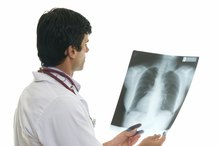What Are the Treatments for a Broken Sternum?
The sternum -- commonly known as the breastbone -- is the strong flat bone in the center of the chest. It is attached by short pieces of cartilage to the upper 7 ribs on each side. A broken sternum is usually the result of a powerful blow to the front of the chest. Most sternal fractures are caused by motor vehicle accidents 2. Treatment of these fractures depends on the severity of the break.
If you are experiencing serious medical symptoms, seek emergency treatment immediately.
Rest and Ice
Rest and limiting activities may be the only treatments needed for minor breaks or cracks in the sternum. The average recovery time for sternal fractures is about 2 to 3 months, according to a review article published in the “Journal of Emergencies, Trauma, and Shock” in April-June 2013 23. During that time, any movement or activity that makes the pain worse should be avoided, when possible.
Ice may be applied for 20 minutes every 2 to 4 hours for the first 3 days following the fracture. This will help reduce pain and swelling.
- Rest and limiting activities may be the only treatments needed for minor breaks or cracks in the sternum.
Pain Medications
Symptoms of a Broken Sternum
Learn More
Pain with a sternal fracture typically worsens with breathing, especially when taking a deep breath or coughing. Because of this, people may naturally try to avoid deep breathing or coughing. But this can cause problems, as it increases the possibility of developing pneumonia. Pain may also be caused by other injuries that sometimes accompany a sternal fracture, such as broken ribs.
When the severity of the break is mild to moderate, non-steroidal anti-inflammatory medications (NSAIDs) such as ibuprofen (Advil, Motrin) or naproxen (Aleve) may be sufficient for pain relief. Because these medications can cause bleeding, they should only be used for a sternal fracture if recommended by a doctor. If NSAIDs fail to provide adequate relief, stronger painkillers, such as opioids, may be prescribed.
- Pain with a sternal fracture typically worsens with breathing, especially when taking a deep breath or coughing.
- Pain may also be caused by other injuries that sometimes accompany a sternal fracture, such as broken ribs.
Surgery
Occasionally surgery will be necessary if the fracture is severe enough to cause the bone fragments to move out of place -- called a displaced fracture. Surgery may also be considered if breathing is severely affected. During surgery, the bone fragments are typically joined together with steel wires or with a plate secured in place with screws.
Seeking Medical Care
Pain in the Knee & Occasional Popping When Walking
Learn More
If you are involved in a motor vehicle accident -- no matter how minor -- go to the hospital if you notice any pain in your chest.
As your sternal fracture heals, see your doctor if you develop a fever and cough. These indicate that you may have pneumonia. Seek immediate medical care if you notice shortness of breath, dizziness or fainting, as these suggest that you may also have a serious injury to your lungs or heart.
Reviewed by Mary D. Daley, M.D.
- If you are involved in a motor vehicle accident -- no matter how minor -- go to the hospital if you notice any pain in your chest.
- Seek immediate medical care if you notice shortness of breath, dizziness or fainting, as these suggest that you may also have a serious injury to your lungs or heart.
Related Articles
References
- Veterans-UK: Sternal Fractures
- Journal of Emergencies, Trauma, and Shock: Sternal Fractures and Their Management
- Kumar NS, Bravian D, More AB. Xiphoid foramen and its clinical implication. Int J Anat Res. 2014;2:340-343.
- Gkantsinikoudis N, Chaniotakis C, Gkasdaris G, Georgiou N, Kapetanakis S. Morphological approach of the sternal foramen: an anatomic study and a short review of the literature. Folia Morphol (Warsz). 2017;76(3):484-490. doi:10.5603/FM.a2017.0006
- Khoriati AA, Rajakulasingam R, Shah R. Sternal fractures and their management. J Emerg Trauma Shock. 2013;6(2):113-6. doi:10.4103/0974-2700.110763
- Anderson BW, Burns B. Anatomy, thorax, xiphoid process. Treasure Island, FL: StatPearls Publishing. Updated December 9, 2018.
- Proulx AM, Zyrd TW. Costochondritis: diagnosis and treatment. Am Fam Physician. 2009;80(6):617-620.
- Yoo WG. Effects of combined chest expansion and breathing exercises in a patient with sternal pain. J Phys Ther Sci. 2017;29(9):1706-1707. doi:10.1589/jpts.29.1706
- Ayloo A, Cvengros T, Marella S. Evaluation and treatment of musculoskeletal chest pain. Prim Care. 2013;40(4):863-87. doi:10.1016/j.pop.2013.08.007
- Singh K, Anderson E, Harper JG. Overview and management of sternal wound infection. Semin Plast Surg. 2011;25(1):25-33. doi:10.1055/s-0031-1275168
- El-Ansary D, Lapier TK, Adams J, et al. An evidence-based perspective on movement and activity following median sternotomy. Phys Ther. 2019. doi:10.1093/ptj/pzz126
Writer Bio
A registered nurse with more than 25 years of experience in oncology, labor/delivery, neonatal intensive care, infertility and ophthalmology, Sharon Perkins has also coauthored and edited numerous health books for the Wiley "Dummies" series. Perkins also has extensive experience working in home health with medically fragile pediatric patients.








